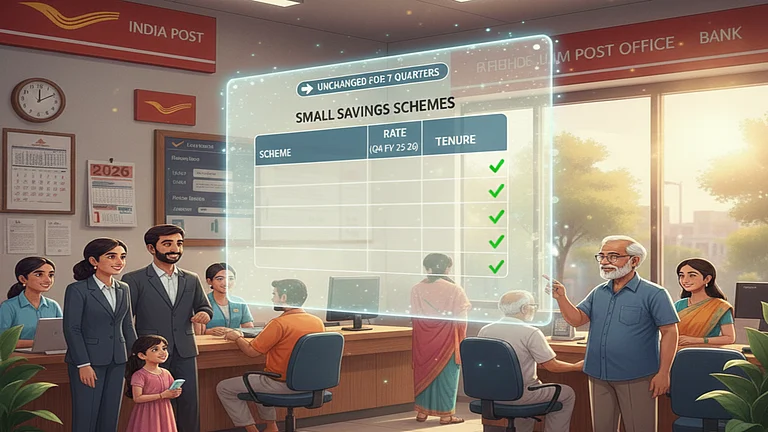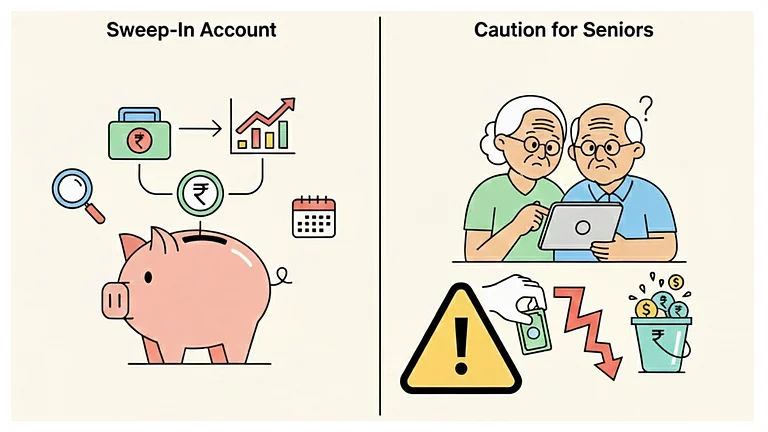
Summary of this article
· 70 per cent of India's elderly depend on others, lacking pensions
· SCSS offers up to Rs 30 lakh investment with an 8.2 per cent return
· POMIS provides monthly income with a minimum investment of Rs 1,000
India’s 70 per cent of the elderly population is dependent on children or others for their daily maintenance. Notably, 78 per cent of the elderly live without pension coverage, according to Niti Aayog’s data. It shows they do not have an assured income. However, even if there is no source like a pension, there are investment schemes that offer a fixed and guaranteed income. The only requirement is to have some savings and a planned investment in these schemes, which can offer a regular income even when one does not earn fresh income, like a government pension.
Here are five investment instruments to get a regular income:
Senior Citizens Saving Scheme (SCSS)
This scheme is only for senior citizens. They can invest a minimum of Rs 1,000 and a maximum of Rs 30 lakh in the SCSS scheme. This is like a fixed deposit (FD) account, which can be opened with the post office or banks. Seniors can open more than one account as well; however, the total investment in them cannot exceed the Rs 30 lakh limit. The interest amount is guaranteed by the government and paid on a quarterly basis. While the government reviews the interest rate every quarter, investors’ interest rate is blocked for five years at the time of account opening. At present, SCSS offers 8.2 per cent interest.
Post Office Monthly Income Account (POMIS)
Investment in monthly income schemes in the post office ensures a regular cash flow that seniors can depend on because these offer a sovereign guarantee. The minimum investment is Rs 1,000 and the maximum is Rs 9 lakh in a single account and Rs 15 lakh in a joint account. At present, one can earn 7.4 per cent interest payable monthly. This account is opened for five years, but can be closed after one year by paying a penalty ranging from 1-2 per cent, depending on the period the account was held.
Fixed Deposits With Banks
One can also opt for bank FDs where the tenure is not a fixed five years. Different banks set their own FD tenures and interest rates and offer the option to reinvest the interest in the FD until maturity or receive a monthly or quarterly credit of interest in one’s savings accounts. Usually, banks offer a 40 to 75 basis points additional interest rate to seniors. Of late, many banks have reduced their FD interest rates and are offering interest rates in the range of 6.5 per cent to 8.00 per cent, barring a few exceptions. This is to align with the Reserve Bank of India’s (RBI) 1 per cent repo rate cut this year.
RBI Floating Rate Savings Bonds
Kavita Bothra, Partner, Primassure LLP, a wealth management firm, suggests that RBI’s floating rate bonds would be an option for those looking for guaranteed income. She says, “These bonds are reset every six months based on the National Saving Certificate (NSC) rate + 0.35 per cent. They offer safety, but payouts are semi-annual and unsuitable if you need a monthly income.”
However, one should not forget that while the interest is guaranteed, it is floating, which means it may change when the interest rate for NSC is changed. For example, the 5-year NSC interest rate was 6.8 per cent for July-September of 2020, which is now 7.7 per cent (July-September quarter of 2025).
Systematic Withdrawal Plan From Mutual Funds
Typically, senior citizens with limited savings do not prefer taking risks by investing in equities or other riskier investment avenues. However, their risk-averse attitude may work against them over the years due to inflationary pressures. While experts suggest equities as an investment for the long term, one may consider a systematic withdrawal plan of mutual funds for a regular cash flow.
Seniors can opt to invest in debt mutual fund schemes, which provide monthly dividends to get a regular payout, or choose a systematic withdrawal plan (SWP) from MF investments as per their requirement.
Bothra suggests, “For those with a moderate risk appetite, this route can offer better post-tax returns, but professional advice is a must”, and adds, “The key is laddering your investments—mix liquid needs with medium and long-term buckets. Don’t go all-in on one product. Diversification is peace of mind.”
In addition to this, the National Pension System (NPS) could also be an option for a regular income. It offers annuity for life, and one can invest in the scheme up to the age of 70.
So, while seniors seek a regular income, to keep the cash flowing, they need to plan their savings in a way that it grows with their age and is not stuck in non-liquid assets. Many times, the seniors have assets in the form of a house but lack a cash flow.
However, with the availability of assured return instruments and proper financial planning, they can plan to manage cash flow.



















